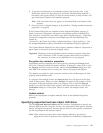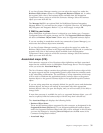
Chapter
4.
Understanding
business
objects
v
“Business
object
structure
and
relationships”
v
“Business
object
application-specific
information”
on
page
39
This
chapter
describes
how
the
connector
processes
business
objects.
To
properly
create
or
modify
business
objects
for
Siebel,
you
must
understand
the
object
relationships
within
the
Siebel
architecture.
Note:
This
chapter
includes
references
to
Event
and
Archive
business
components,
business
objects,
and
tables.
These
references
are
synonymous
with
references
to
CW
Event
and
CW
Archive
that
appear
in
earlier
versions,
and
with
references
to
IBM
Event
and
IBM
Archive
that
appear
in
Siebel
7.5
Business
object
structure
and
relationships
The
connector
supports
Create,
Retrieve,
Update,
Delete,
Exists,
Retrieve
By
Content,
and
DetlaUpdate
verbs
for
a
Siebel
application-specific
business
object
whose
semantics
are
encapsulated
in
its
business
object
definition.
There
is
no
connector
logic
that
processes
a
Siebel
application-specific
business
object
according
to
hard-coded
instructions
in
the
connector.
For
example,
the
connector
does
not
expect
a
particular
business
object
to
consist
of
a
certain
type
and
number
of
entities.
What
the
connector
expects
is
that
any
object
may
consist
of
one
or
more
entities.
Siebel
business
components
can
be
associated
in
three
ways.
They
can
be
linked
in
one-to-one
relationships
through
single-valued
links,
or
they
can
have
Multi-Value
Link
(MVL)
fields
representing
one-to-many
relationships,
or
they
can
have
a
simple
link.
Business
components
can
be
associated
in
many-to-one
relationships
by
means
of
PickLists.
Business
component
methods
provide
support
for
searching
a
PickList
business
component
for
a
specific
value
and
placing
that
value
in
a
field.
Finally,
business
components
can
be
associated
in
many-to-many
relationships
through
intersection
tables.
If
there
are
two
unrelated
single
cardinality
business
components
under
the
same
business
object
in
Siebel,
a
separate
business
object
wrapper
needs
to
be
created.
In
order
to
support
the
Siebel
concept
of
a
business
object
context
encapsulating
numerous
business
components,
a
top-level
business
object
should
correspond
to
the
appropriate
Siebel
business
object.
The
top-level
business
object
application-specific
information
should
contain
the
name
of
the
corresponding
Siebel
business
object.
Each
top-level
attribute
should
then
correspond
to
a
Siebel
business
component.
Within
a
business
object
definition
that
corresponds
to
a
business
component,
each
attribute
specifies
either
a
simple
field,
or
a
Multi-Value
Group
(MVG)
field.
The
attribute
data
in
simple
attributes
should
have
simple
data
types.
Attributes
that
correspond
to
MVG
fields
should
be
treated
as
child
(container)
business
objects.
This
business
object
structure
is
part
of
the
meta-data
that
allows
the
connector
to
handle
all
business
objects
in
the
same
manner.
The
connector
can
support
additional
Siebel
objects
if
a
business
object
definition
is
specified
for
the
object.
©
Copyright
IBM
Corp.
1997,
2004
37


















